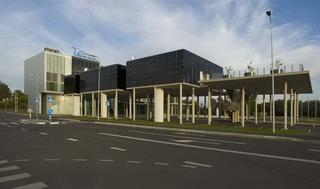Ülemiste Hotel
Almost nothing remains of the former Aeroflot Hotel on the shores of Lake Ülemiste. All that remains of that narrow building are some barely noticeable supporting constructions. The hotel structure that at first glance appears to be complicated is divided into a five-storey hotel prism with glass facades. A concrete tongue bearing three cubes covered by black glass projects from the glass stairwell screen of the front side of the building. The parking lot for hotel guests is under this in a dense forest of concrete poles. Guests should upon first arrival circle around the fountain before parking because the architecture full of nuances, abundant glass and concrete, has a particularly film-like effect when one drives around the pool of the fountain.
Two of the three cubes contain conference rooms. The one closest to the lake is an impressive nightclub that plays with stylistic devices from the 1970s. It can be accessed from the hotel as well as directly by the stairs between the cubes. There is a hanging garden in front of the nightclub cube that is referred to as the grilling garden in the summertime.
As can be expected, the primary materials of this new building are white concrete and glass, also metal, and stained wood finishing runs through the interior of the building. The way these materials are used, however, is noteworthy. It is emphasized by high-standard construction quality. The creation of a forest of such slender concrete poles supporting the cubes and the thin concrete tongue required especially precise engineering calculations.
The poured concrete of the alcohol wall of the lobby bar becomes particularly complex. The concrete of the interior has discernible traces of the framework into which it was poured, leading to a slight retro flavour reminiscent of the early period of enthusiasm regarding concrete.
Perhaps even the most important factor of this building is its unique location on the shore of Lake Ülemiste. The management of the panoramic view that is the calling card of the hotel is designed to be festive.
The building celebrates simplicity and spirituality as much it does elegance and refinement. The barriers between outside and inside has been minimized. The completed contemporary architectural whole that was carefully thought out in detail and the slight 1970s flavour of the interior should please even the most sensitive visitors.
Urmas Oja, Estonian Architectural Review Maja 3-2004










